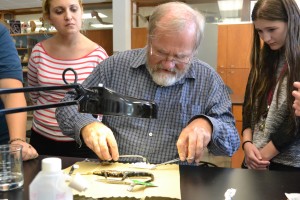Tiger salamanders lead the way to wetland conservation

Professor of biology, Paul Bartelt performs surgery to implant a tracking device into a Eastern tiger salamander. Photo by Audrey Sparks
By Audrey Sparks
The Waldorf Biology lab was recently turned into a mini-operating room. Paul Bartelt, Waldorf professor of biology, and Elyse DeVries, biology lab manager, surgically implanted tracking devices into two Eastern tiger salamanders. The salamanders are a part of an on-going tracking program with an eye on environmental restoration.
“Two years ago we were looking for frogs and we had all of these pitfall traps and we had a mass migration of salamanders come through,” DeVries said. “I caught 88 salamanders in two weeks. So we were like, huh, we have something going on here, let’s find out more.” As DeVries and Bartelt began to discuss what they did know about salamanders, they quickly discovered there was little information about these otherwise well-known animals. But, why all the fuss over salamanders anyway?
“Amphibian populations are in a serious hurt,” Bartelt said. “One-third of all species are either endangered or declining. Here in Iowa the salamander has declined in much of the state.”
And when a decline in salamanders and other small amphibians occurs, the biology world gets concerned. “They are considered kind of like a canary,” DeVries said. “They are a very integral part of all of the ecosystems, so if something like an amphibian starts to die off, that is going to lead to everything else.”
Part of the reason for the decline in population is due to habitat loss from farming. According to the Natural Resources Conservation Service (NRCS) of Iowa over 90 percent of wetlands in Iowa have been drained for agriculture and development. This drainage has a direct impact, not only on the animal life dependent on those environments for survival, but also on the surrounding areas. “They (wetlands) are also important to the hydrology. They store water,” Bartelt said. “The Midwest can have some terrific flooding, and that is due in part to when you drain all of the agricultural land, and you shoot that water into the rivers; the rivers just go downstream and they fill up very quickly. Then you get to these urban areas where you have a broad floodplain and up goes the water flooding the area.”
Wetlands also provide a filter system to aide in cleaning water of agricultural pollutants which would otherwise flow into the river systems.
Thankfully the decline in wetlands hasn’t gone unnoticed. The NCRS began wetland restoration projects in the early 90’s and as of today over 12,000 acres of wetlands have been restored in Winnebago County alone.
Enter the tiny, tracker-carrying, Eastern tiger salamander. The tracking of these little amphibians will provide much needed information about the proper method of restoring the wetlands in order to facilitate the ultimate goal, the preservation of salamanders within these environments. “Perhaps it will help us in learning what the wetland densities need to be, or is there a way to construct them within a prairie that facilitates their (the salamander) movement in finding other wetlands,” Bartelt said. “The more we can learn about their natural history and how they are responding to wetland restoration, and how they use the landscape, the better we can conserve them.”
To date the surgical duo has operated on 16 salamanders with only one fatality during the operating process. The process is quite quick, only lasting 30 minutes max including anesthetizing, which takes 10-15 minutes.
Of those released many have been lost to predation. “We’ve had to capture snakes, bring them into the lab, and wait to get the tracking device back,” DeVries said.
Others have been lost because of their natural instinct to roam. “It’s tough being green, because they don’t understand political boundaries,” Bartelt said. “They don’t understand what a fence line means. They don’t understand what a heavy implement is all about and so they take off, and we’ve lost a number of animals to agricultural practices.”
Even with losses to farming, Bartelt maintains a positive attitude of community. “Am I condemning the farmers? No. I’m just saying that these amphibians do not understand what we are doing here,” Bartelt said. “We’re sure grateful to the landowners that let us go on their land and grateful to the interest people show.”
If you would like to be a part of this project DeVries and Bartelt encourage anyone who sees a salamander to pick them up and bring them in. They instruct to document the exact location where the salamander was located and the date so once the animal is fitted with a tracker it can be returned to the same location for release in a timely manner. To bring one in, simply place it in a shallow container with 1/4 inch of water and bring it to the Waldorf College biology lab within a day capture. If you have further questions you can contact Elyse DeVries at Elyse.DeVries@waldorf.edu or Paul Bartelt at barteltp@waldorf.edu.
